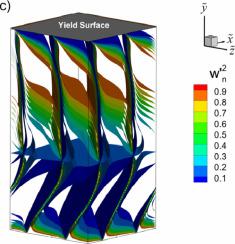Journal of Non-Newtonian Fluid Mechanics ( IF 3.1 ) Pub Date : 2020-05-27 , DOI: 10.1016/j.jnnfm.2020.104316 H. Rahmani , S.M. Taghavi

|
In the present paper, the effects of a channel symmetric wall slip are investigated on the stability of plane Poiseuille flow of a Bingham fluid, based on the modal and non-modal linear stability analysis approaches. Both streamwise and spanwise slip conditions are considered and their results are compared with those of the no-slip condition, in terms of the flow stability. The results are obtained for different dimensionless groups that govern the stability picture, for example the Bingham number, the Reynolds number and the streamwise/spanwise slip numbers. The linearized perturbation equations are obtained and the corresponding eigenvalue problem is solved based on the Chebyshev collocation method at the Gauss-Lobatto grid points, using the QZ algorithm. In the modal analysis, the focus is on the changes made by the channel wall slip on the eigenvalue spectra. The flow is shown to be linearly stable for no-slip and streamwise slip conditions. However, for the spanwise slip condition, an unstable eigenvalue is found for large values of the spanwise slip number. The non-modal stability analysis is based on the transient energy growth of the perturbations, which is calculated using the eigenfunctions of the eigenvalue problem representing the amplitude of the perturbations. Increasing the streamwise slip decreases the maximum energy growth, eventually leading to a flow for which the transient energy only decays in time. Thus, two distinct flows showing the energy growth and energy decay regimes can be identified, for a range of Bingham, Reynolds and streamwise slip numbers.
中文翻译:

壁滑存在下通道中宾厄姆流体的平面Poiseuille流动的线性稳定性
在本文中,基于模态和非模态线性稳定性分析方法,研究了通道对称壁滑对宾汉流体的平面泊固流稳定性的影响。考虑了顺流和顺滑条件,并就流动稳定性将其结果与不顺滑条件进行了比较。对于控制稳定性图片的不同无量纲组(例如Bingham数,雷诺数和流向/跨向滑移数),将获得结果。利用QZ算法,基于Chebyshev配点方法,在Gauss-Lobatto网格点上,基于线性化的摄动方程,求解了相应的特征值问题。在模态分析中 重点是由通道壁滑移在特征值谱上产生的变化。对于无滑移和顺流滑移情况,流量显示为线性稳定。但是,对于翼展方向滑移条件,对于大的翼展方向滑移数值,发现一个不稳定的特征值。非模态稳定性分析基于扰动的瞬态能量增长,它是使用代表扰动幅度的特征值问题的特征函数来计算的。流向滑动的增加会降低最大能量增长,最终导致瞬态能量仅随时间衰减的流。因此,两个不同的流程显示了 对于较大的翼展方向滑移数,发现一个不稳定的特征值。非模态稳定性分析基于扰动的瞬态能量增长,它是使用代表扰动幅度的特征值问题的特征函数来计算的。流向滑动的增加会降低最大能量增长,最终导致瞬态能量仅随时间衰减的流。因此,两个不同的流程显示了 对于较大的翼展方向滑移数,发现一个不稳定的特征值。非模态稳定性分析基于扰动的瞬态能量增长,它是使用代表扰动幅度的特征值问题的特征函数来计算的。流向滑动的增加会降低最大能量增长,最终导致瞬态能量仅随时间衰减的流。因此,两个不同的流程显示了 最终导致瞬态能量仅随时间衰减的流。因此,两个不同的流程显示了 最终导致瞬态能量仅随时间衰减的流。因此,两个不同的流程显示了对于一定范围的Bingham,Reynolds和沿流滑动数,可以确定能量增长和能量衰减方式。



























 京公网安备 11010802027423号
京公网安备 11010802027423号